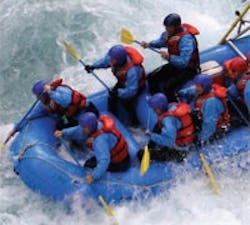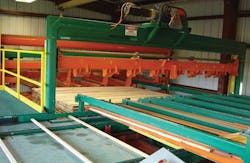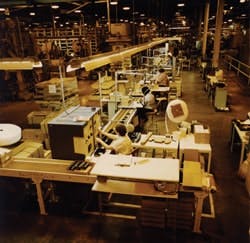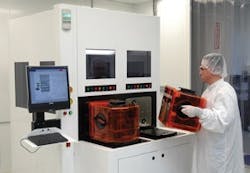Virtual Simulation Tools Allow Engineers to Work Together in an Electronic Environment
Every phase of a project now can be conducted either face-to-face or remotely using e-design tools. Best practices come from selecting the right type of meeting for each phase of the project and using the correct e-design tools as needed.
But despite the ubiquity, low cost and ease-of-use of these new design tools, there are some instances where face-to-face meetings are required.
The Whites of Their EyesRemote e-design collaboration saves travel time, is cheaper and is easier to set up, but face-to-face meetings deliver advantages. “There is a genius to human interaction only brought out by close face-to-face involvement,” believes Jim Butler, president of IntePro, Waynesburg, Pa. IntePro builds manual and semi-automatic workstation setups that are integrated into continuous-flow manufacturing lines (Figure 1). “Direct human interaction is needed at specific times throughout a collaboration to create the atmosphere for truly effective brainstorming and creativity and to make the leaps of progress that bring high achievement,” adds Butler. “The cost and time concerns for such progress are insignificant in the context of a well-balanced face-to-face and e-design collaboration.”
A subset of e-design is remote access and support for machines and systems installed in the field. “From our home office, we can connect to a system anywhere in the world to remotely view the operator interface and connect with the PLC controlling the machine,” says Keith Gardener, product engineering manager at MPI in Poughkeepsie, N.Y. MPI builds wax injection-molding machines and automated pattern assembly systems for the investment casting industry.
MPI first establishes a VPN connection to a customer’s network—a network controlled by the customer. The VPN normally is disabled and activated only by the customer when required. Client VPN policies establish MPI’s limits for network access. After a VPN is established, connection to each machine requires a separate login.
“Remote access allows us to provide training, setup advice and troubleshooting,” adds Gardener. “We can also update machine operating sequences. We use InduSoft Web Studio as the HMI and the Web server. This allows us to remotely see the same screens as the operator via Internet Explorer, but some issues such as mechanical breakdowns still need hands-on diagnosis.”
MoCo Engineering & Fabrication in Spokane Valley, Wash., builds lumber-handling equipment for the wood products industry. “We offer a remote-access option to our customers via a Web port device that uses open VPN tunnel technology,” explains Loren Wernecke, electrical and hydraulic manager and field service specialist at MoCo. “Once the tunnel is created, we can connect to any Ethernet device on the private side of the Web port, as if we were on-site. We can modify device settings, change programs and troubleshoot equipment. This allows us to be highly responsive to customer demands in the most efficient and economical manner possible.”
System integrator Optimation, Rush, N.Y., currently is setting up secure client portals accessible through its website to share documents, manage schedules, support project blogging and provide revision control for shared data.Despite this commitment to e-design, Optimation knows it can’t fully replace on-site meetings. “From a service supplier point of view, e-design can have some drawbacks for new customers,” says Dan Curry, PE, senior process engineer at Optimation. “It can take longer to build a relationship and form trust when you’re not working on-site, so we try to meet with each client face-to-face before a project begins. No form of e-design will ever be able to give you the nonverbal cues that you get in a face-to-face meeting. A client’s nonverbal communication often is more powerful than what is said.”
A leading machine builder agrees. “Face-to-face meetings include body language, and participants have a greater sense of being a stakeholder in their actions,” notes Raymond McKinney, senior condition-monitoring specialist at Dresser-Rand, Olean, N.Y. Dresser-Rand makes industrial reciprocating and centrifugal compressors, steam turbines and their associated control systems.
Integrated Process Engineers & Constructors in Fort Atkinson, Wis., is a process system design and build specialist for the food, dairy, beverage and pharmaceutical/biotech industries (Figure 2). Gary Johnson, project manager with the company, says, “Face-to-face meetings can be useful, especially near the beginning of the design process. A trip to the client’s facility lets the engineer see design considerations and limitations that would not be apparent in descriptions, drawings or pictures.”
This automation supplier clearly values personal meetings. “Face-to-face meetings play an important role in customer relationship-building,” says Bill Savela, marketing director at Delta Computer Systems. “When a company commits to using a Delta controller, it bets the success of its own business and reputation on our ability to meet its needs,” adds Savela. “With stakes this high, in-person interaction is important to build trust.”
E-Design Advantages
No matter the e-design tool employed, remote interactions have some important advantages over in-person meetings. “E-design saves time during each stage of the design process and makes it easier for clients to give input,” observes IPEC’s Johnson. His firm uses email, FTP file-sharing websites, Web-based virtual meetings and document-sharing software.
Owens Design in Fremont, Calif., makes highly automated and complex machines used primarily in the semiconductor, disk media and solar industries (Figure 3). It uses virtual meeting software for long-distance interactions and CAD software to exchange models. Typically, a customer views its portion of the project via models used to check for fits into manufacturing lines. “We find that e-design saves the cost and time of flying engineers to customer sites,” says Bob Fung, director of engineering at Owens. “It’s also more productive due to the rapid exchange of models we can update or change very quickly.”
System integrators see the value of e-design for both themselves and their clients. “E-design allows us to respond immediately without the time and expense required to travel from New York to anywhere in the world,” notes Keith Gardener, product engineering manager at MPI, Poughkeepsie, N.Y. MPI makes wax injection-molding machines and automated pattern-assembly systems for the investment casting industry. “By eliminating travel time to and from the field, it also frees up our service engineers’ schedules. The only drawback is that not all customers have the resources or systems in place to support the remote connectivity, making initial setup difficult.”
Larry Wells, PE, principal with industry consultant CCSA in Lawrenceville, Ga., says, “Remote meetings can be set up much more quickly, and more people can attend, which brings in additional firsthand information. If an electronic talking tool such as virtual meeting software is used, information is generated in real-time so that all can see and concur with the information that appears on their computer screens.”
Document management also improves with e-design. “Remote design allows us to keep all our design documents on a single computer in the office and access the design database and drawings via an Internet connection,” says Stephen Carter, president of LT Software Solutions, Portsmouth, N.H. “We use Aucotec’s Engineering Base software to provide services to our clients from our office and from remote locations. With the software, on several occasions I have been able to provide last-minute changes to OEM client design documents and on-site customer data from an airplane seat.”
E-meetings eliminate travel costs and time, adds McKinney of Dresser-Rand. “This makes it possible to pull working groups together faster with the full expertise needed to handle a particular problem, rather than just sending someone who is available,” he argues. “As travel costs are eliminated, it is feasible to have newer employees attend meetings to gain exposure.”
Email Is Everywhere, but ...
The most ubiquitous and widely used e-design tool is the humble email. Now that almost everyone has an email account with remote as well as local access, email is even more popular.
“Email is invaluable for quick and concise questions and answers. But general rules on flags or subject line codes must be agreed upon, or the value of project emails will be compromised by getting lost in the sheer volumes,” says Butler of IntePro.
“The major disadvantage of emails is over-reliance on them for conversational communications,” adds Butler. “This leads to peripheral people becoming involved when they shouldn’t be and email storms in which communication devolves into confusion and possibly to destructive conclusions.”
Email attachments of drawings and documents save the time and expense of package deliveries, notes Johnson. “FTP sites are also useful tools for the transmittal of large drawings or documents that would exceed the size limitations of many email servers.”
Optimation’s Curry is a fan of file-sharing sites. “We use FTP sites to share large data files such as drawings and other project information,” he says. “FTP sites are great. They’re a secure place for the client and Optimation to quickly share information. We get current versions of active documents and drawings, and we make extensive use of up-to-date action item lists on the site. By keeping the FTP site as the main storage place, we cut rework issues because everyone is now using the most current version of each drawing and document.”
It’s a Virtual World
It started with the phone more than a century ago and then proceeded to conference calls and finally to video conferencing. Virtual meeting software borrowed the phone-conferencing concept and incorporated the Internet, and now it’s used often in conjunction with phone conferencing.
“Web-based virtual meetings with simultaneous conference calls allow active input from the clients during the design process,” explains IPEC’s Johnson. “Clients are able to view a 3D model of the system without needing design software installed on their computers. Viewing a 3D model at different stages of the design process allows clients to understand the design decisions and the impacts.”
Butler of IntePro has some advice for making virtual meetings more productive. “Virtual meetings bring people together well for general reviews and light problem-solving but are limited for creative sessions,” he states. “Facilitators need to continually monitor quality of progress and of interaction between participants. For instance, watch out for over-reliance on the convenience and lesser accountability of remote meetings. Our experience shows that about a third of general review sessions need to be face-to-face. Depending on project length or special circumstances, in-person meetings should occur at least once every six weeks.”
Video conferencing might one day be the ultimate in virtual meetings, combining the advantages of face-to-face gatherings with the low cost of remote collaboration. “Optimation is heading toward video conferencing, but not everyone is ready for it,” thinks Curry. “We do think that it will become standard practice over time because nonverbal communications are so important.”
CAD Tools
Machine builders, their customers and their suppliers use 3D CAD products to improve the design process. “In the selection of a six-axis robot for one of our machines, the reach and movements were tested using the SolidWorks drawings of our framework that were sent to Staubli, the robot manufacturer,” says Bob Horrell, manager of sustaining engineering at Strasbaugh, San Luis Obispo, Calif. Strasbaugh makes wafer-polishing machines for the semiconductor industry, as well as grinding and polishing machines for the precision optics industry. “In two Web conferences, the robot was articulated by Staubli within the space of our SolidWorks model,” explains Horrell. “Several robot manufacturers quoted on the project, but only Staubli had the 3D capability for placing the robot in our framework and articulating it to all the required target locations. The model next was emailed to Staubli for incorporation in its animation demo, which was in real time to our engineers. Subsequently, further iterations were sent to us from Staubli so the animation could be run here to achieve the end design.”
CAD Tech Resources knows some of the nuances of using the Web to manage CAD drawings. “Our clients use our Web Drawing Manager to securely share drawings, files and pictures among team members worldwide via electronic folders,” says Tom Armstrong, CAD Tech’s president. “Current documents are uploaded easily and available to all team members. Distribution using email isn’t necessary and doesn’t clog in-boxes with long downloads of multi-megabyte drawings. When a new version is uploaded, previous versions of all files are automatically saved for reference as needed.”
Users edit the current version, which locks the file until they upload changes and release the lock. CAD administrators or project managers set permissions for each group of users to control access and ability to change designs.
- Relationship building
- Nonverbal clues are transmitted
- Can see machines and manufacturing lines firsthand
- Easier to draw-in important but reluctant participants
- Easier to communicate among larger groups
- More accountability among participants
Newer versions of CAD software have more options for document sharing, thinks IPEC’s Johnson. “A simplified version of a 3D model can be created that the client can view using a free companion program from the software manufacturer,” he says. “The client can view the 3D model but not make modifications.”
The Right Mix
Most projects use both in-person and remote e-design, with the optimal mix being determined by the client. “The customer dictates the amount of required face-to-face meetings,” says Lee Hilpert, president of HilTech, a system integrator in Tomball, Texas. “Some customers feel very comfortable with e-design and need few in-person meetings, but others just aren’t comfortable doing business remotely. We find that the more a company embraces new technology, the more open they are to e-design.”
- Saves cost
- Saves time
- Easier for more to participate
- Easier to manage version control
- Encourages more frequent interactions
When determining the right mix of technologies to use for each project, it’s wise to consider the pros and cons of each approach. “We use WebEx for project, purchase order and contract review of schedule, progress and issues,” relates Bill Robertson, project manager at Emerson Process Management. “Remote e-design allows for immediate online communication of design changes or updates, and it minimizes travel costs and time.”
E-Designing StandardsWorldwide standards organizations require long-term and ongoing collaboration among members located across the globe, making them a great fit for remote e-design. GE Energy’s Steve Sabin is the secretary of the American Petroleum Institute’s Subcommittee for Mechanical Equipment (SOME) 670 5th Edition Task Force. Subcommittee participants include machine builders, machine end users, engineering firms and instrument vendors, and they are responsible for several dozen standards related to rotating and reciprocating machinery used in the petroleum industries. “When I last worked on SOME task forces for API 612 and API 670 back in 1998-2000, all meetings were face-to-face. Participation was limited because of required travel, and many companies simply stopped supporting API activities due to travel time and cost,” observes Sabin. In 2008, Sabin participated in revisions of the standards he worked on in 1998-2000. “In the intervening 10 years, things changed,” he states. “Now, only two meetings per year are conducted face-to-face. The rest of the time, we do everything via WebEx and teleconference. Our 50 task-force members share screens, make edits on the fly and generally conduct business in a virtual meeting format.” Sabin says his work on the task forces and committees was revolutionized by this technology. “When working on the fourth edition of API 670, I traveled more than 15 times in 24 months,” he marvels. “Since we have started on the fifth edition, I’ve had to travel twice in 12 months. We also have greater participation from outside North America. Finally, the ability to post materials to a website for task-force participants to review when they miss a meeting is much easier than the old method of faxing or snail-mailing documents around the world.” |
What mix of face time plus e-tool-enabled collaboration makes the most effective combination? Voice an opinion and check the pulse of Machine Builder Nation at www.ControlDesign.com/edesign.
Free 3DHilTech, a system integrator in Tomball, Texas, uses eDrawings, a free SolidWorks product, to convey important engineering information to its clients and suppliers. “EDrawings is an invaluable tool that gives us the confidence to do up-front work without face-to-face meetings,” says HilTech President Lee Hilpert. “It allows us to listen to client needs and then send clients an interactive 3D model of what we envision will meet the project requirements. Having a fully interactive 3D model also allows the customer to see potential pitfalls and design improvements that might not otherwise be recognized until later into the project when corrections become more costly.” Hilpert says he also used eDrawings extensively at his prior employer, machine builder Hutchison Hayes. “We did a lot of development work with our sister company in New Zealand,” states Hilpert. “Face-to-face meetings were limited, and so we used e-design technology to get the job done. That’s when I realized the value of this technology and truly embraced it as a preferred way of collaborating with customers and vendors.” |
About the Author

Leaders relevant to this article:







